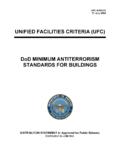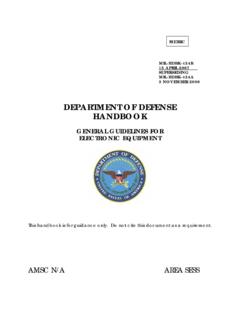Transcription of REPORT DOCUMENTATION PAGE - Defense Technical …
1 Standard Form 298 (Rev. 8-98) Prescribed by ANSI Std. Z39-18 REPORT DOCUMENTATION PAGE Form Approved OMB No. 0704-0188 The public reporting burden for this collection of information is estimated to average 1 hour per response, including the time for reviewing instructions, searching existing data sources, gathering and maintaining the data needed, and completing and reviewing the collection of information. Send comments regarding this burden estimate or any other aspect of this collection of information, including suggestions for reducing this burden, to Department of Defense , Washington Headquarters Services, Directorate for information on Operations and Reports (0704-0188), 1215 Jefferson Davis Highway, Suite 1204, Arlington, VA 22202-4302. Respondents should be aware that notwithstanding any other provision of law, no person shall be subject to any penalty for failing to comply with a collection of information if it does not display a currently valid OMB control number.
2 PLEASE DO NOT RETURN YOUR FORM TO THE ABOVE ADDRESS. 1. REPORT DATE (DD-MM-YYYY) 21-09-2009 2. REPORT TYPE Final 3. DATES COVERED (From - To) 4. TITLE AND SUBTITLE Test Operations Procedure (TOP) 1-2-511 Electromagnetic Environmental Effects System Testing 5a. CONTRACT NUMBER 5b. GRANT NUMBER 5c. PROGRAM ELEMENT NUMBER 6. AUTHORS 5d. PROJECT NUMBER 5e. TASK NUMBER 5f. WORK UNIT NUMBER 7. PERFORMING ORGANIZATION NAME(S) AND ADDRESS(ES) Survivability, Vulnerability & Assessment Directorate (TEDT-WSV-E) US Army White Sands Missile Range White Sands Missile Range, NM 88002-5178 8. PERFORMING ORGANIZATION REPORT NUMBER TOP 1-2-511 9. SPONSORING/MONITORING AGENCY NAME(S) AND ADDRESS(ES) Test Business Management Division (TEDT-TMB) US Army Developmental Test Command 314 Longs Corner Road Aberdeen Proving Ground, MD 21005-5055 10.
3 SPONSOR/MONITOR S ACRONYM(S) 11. SPONSOR/MONITOR S REPORT NUMBER(S) Same as item 8 12. DISTRIBUTION/AVAILABILITY STATEMENT Approved for public release, distibution unlimited. 13. SUPPLEMENTARY NOTES Defense Technical Information Center (DTIC), AD No.: This TOP supersedes TOP 1-2-511, dated 29 December 1989, TOP 1-2-512 Electromagnetic Compatibility Tests dated 15 May 1995 and TOP 6-2-560 Compatibility, Electromagnetic dates 12 October 1979. 14. ABSTRACT This Test Operational Procedure (TOP) provides the Electromagnetic Environmental Effects (E3) interface requirements and verification criteria for airborne, sea, space, and ground systems, including associated ordnance, as stated in military standard (MIL-STD)-464A Electromagnetic Environmental Effects Requirement for Systems , as well as ADS-37A-PRF Aeronautical Design Standard for the Electromagnetic Environmental Effects (E3) Performance and Verification Requirements.
4 15. SUBJECT TERMS Electromagnetic Effects HERO Lightning Electromagnetic Pulse Electrostatic Discharge TEMPEST High Power Microwave 16. SECURITY CLASSIFICATION OF: 17. LIMITATION OF ABSTRACT SAR 18. NUMBER OF pages 169 19a. NAME OF RESPONSIBLE PERSON a. REPORT B. ABSTRACT C. THIS PAGE Uncl Uncl Uncl 19b. TELEPHONE NUMBER (include area code) US ARMY DEVELOPMENTAL TEST COMMAND TEST OPERATIONS PROCEDURE *DTIC AD No. Test Operations Procedure (TOP) 1-2-511 21 September 2009 ELECTROMAGNETIC ENVIRONMENTAL EFFECTS SYSTEM TESTING Page Paragraph: 1. SCOPE .. 2 Environments .. 2 2. FACILITIES AND INSTRUMENTATION .. 3 Facilities .. 3 Instrumentation .. 5 Measurement Tolerances .. 8 3. REQUIRED TEST CONDITIONS .. 9 Test Item.
5 9 Pretest Evaluation .. 10 Policy and Guidance .. 10 Test Setup Calibration .. 13 4. TEST PROCEDURES .. 13 5 DATA REQUIRED .. 13 6. DATA PRESENTATION .. 14 Data Analysis .. 15 Safety Margins .. 15 APPENDIX A. INTRA SYSTEM ELECTROMAGNETIC COMPATIBILITY RECEIVER DESENSITIZATION .. A-1 B. EXTERNAL RF ELECTROMAGNETIC ENVIRONMENT (EME) .. B-1 C. NEAR STRIKE LIGHTNING (NSL) .. C-1 D. ELECTROMAGNETIC PULSE (EMP) .. D-1 E. HELICOPTER GENERATED ELECTROSTATIC DISCHARGE (HESD) .. E-1 F. PRECIPITATION STATIC (P-STATIC) .. F-1 G. HAZARDS OF ELECTROMAGNETIC RADIATION TO FUEL (HERF) .. G-1 H. HAZARDS OF ELECTROMAGNETIC RADIATION TO ORDNANCE (HERO) .. H-1 I. TEMPEST .. I-1 J. HIGH POWER MICROWAVE (HPM) .. J-1 K. INTRA SYSTEM ELECTROMAGNETIC COMPATIBILITY, SYSTEM EMISSIONS, ELECTRIC FIELD, 10kHz to 40 GHz.
6 K-1 * This TOP supersedes TOP 1-2-511, dated 29 December 1989, TOP 1-2-512 Electromagnetic Compatibility Tests dated 15 May 1995 and TOP 6-2-560 Compatibility, Electromagnetic dates 12 October 1979. Approved for public release, distribution unlimited. TOP 1-2-511 21 September 2009 2 INTRA SYSTEM ELECTROMAGNETIC COMPATIBILITY (EMC) SOURCE/VICTIM .. L-1 M. PERSONNEL- BORNE ELECTROSTATIC DISCHARGE (PESD) .. M-1 N. DIRECT STRIKE LIGHTNING (DSL) .. N-1 O. GLOSSARY .. O-1 P. REFERENCES .. P-1 1. SCOPE. This Test Operation Procedure (TOP) provides the Electromagnetic Environmental Effects (E3) interface requirements and verification criteria for airborne, sea, space, and ground systems, including associated ordnance, as stated in military standard (MIL-STD)-464 Electromagnetic Environmental Effects Requirement for Systems 1 Environments.
7 , as well as ADS-37A-PRF Aeronautical Design Standard for the Electromagnetic Environmental Effects (E3) Performance and Verification Requirements 2 or the latest version of the documents as applicable. a. This TOP is applicable for complete systems and platforms, both new and modified, and applies to engineering development, production and sustainment phases of the system ( , E3 life-cycle programs such as hardness and sustainment assurance, and surveillance testing). b. This TOP provides guidance for TEMPEST and test guidance for the addition of test procedures for implementing Electromagnetic Compatibility (EMC), Radiated Emissions (RE), receiver desensitization and electromagnetic (EM) noise on platforms, as well as the MIL-STD-2169B: " High Altitude Electromagnetic Pulse (HEMP) Environment 3 and High Power Microwave (HPM).
8 A test procedure for Grounds and Bonds is not addressed since it sufficiently discussed in MIL-STD-464. For Shielding Effectiveness reference "ASTM E1851-97, Standard Test Method for Electromagnetic Shielding Effectiveness of Durable Rigid Wall Relocatable Structures" for test procedures. c. This procedure applies to all categories of materiel containing electronic, electrical, electro-mechanical , and electro-optical components to include Electrically Initiated Devices (EID) which may be exposed to electromagnetic environments (EMEs) of high-intensity radiated electromagnetic fields in the EM spectrum between 10 kilohertz (kHz) and 45 gigahertz (GHz), electrostatic discharge (ESD), and lightning effects (LE). d. Each system tested is to be monitored for degraded performance or operation. This can be defined as a malfunction, degradation, or as an unacceptable system response.
9 Since each specific system responds differently to the same test environment, the results from the test can only be applied to the specific system under test (SUT) configuration as tested. Therefore testing for each system configuration is required and warrants investigation. Superscript numbers correspond to those in Appendix P, References. TOP 1-2-511 21 September 2009 3 e. The results of the tests conducted as outlined in this procedure will enable an evaluation to be made as to whether the system or platform tested meets the E3 requirements stated herein when subjected to the defined EMEs or conditions. In addition, these tests will enable a survivability assessment to the appropriate EMEs. Finally, these Tests outlined in this TOP will enable an evaluation of whether the system s/platform s operational performance and E3 requirements are met throughout the rated life-cycle of the system or platform.
10 F. The test methods with specific details for each of the specific electromagnetic environments are contained in Appendices A through N. 2. FACILITIES AND INSTRUMENTATION. Facilities. a. The facility must be capable of handling the test item in all of its configurations, from storage to prelaunch/operational and in-flight configurations as applicable; specifically stockpile to safe launch for ordnance items. b. Fabrication facilities are required where instrumentation system(s) can be fabricated and installed in the test item in a manner that will not affect the electromagnetic radiation susceptibility characteristics of the tactical configuration of the test item, and that will protect the instrumentation from EME effects. Instrumentation should consist of sensing elements, transmitting units, and associated interconnections.












